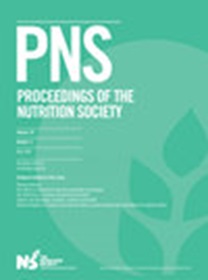在 EPIC-Norfolk 队列中,促炎饮食与较高的 C 反应蛋白和较低的血浆抗炎维生素浓度有关
IF 7.6
2区 医学
Q1 NUTRITION & DIETETICS
引用次数: 0
摘要
研究表明,多种长期疾病(MLTC)的发生与低度慢性炎症有关(1)。膳食炎症指数(DII®)是一种基于文献的膳食评分,用于衡量膳食对个人炎症状态的潜在影响(2)。在这项研究中,我们的目的是根据生物标志物(包括高敏C反应蛋白(hs-CRP)和血浆中维生素C、视黄醇和α-生育酚的浓度)来验证DII®评分,研究对象是基线年龄为39-79岁的欧洲癌症和营养前瞻性调查(EPIC)-诺福克参与者(3)。膳食摄入量被调整为每天 2000 千卡,以评估膳食质量而非膳食数量。在此时间点还测量了非空腹血清胆固醇、hs-CRP、血浆α-生育酚、维生素C和视黄醇浓度。通过自填式健康和生活方式调查问卷收集的数据用于对一些变量进行分类。对具有 DII® 评分和 hs-CRP 测量值的子样本(8,034 名男性和 9,861 名女性)以及维生素 C 浓度(9,866 名男性和 11,702 名女性)、视黄醇浓度(3,673 名男性和 3,517 名女性)和胆固醇调整后的α-生育酚浓度(3,623 名男性和 3,476 名女性)进行了分析。利用协方差分析和线性回归研究了 DII® 分值(已根据年龄、体重指数、吸烟状况、体育锻炼、社会阶层和教育水平进行调整)在不同性别五分位数之间的关联,分值越高,表明饮食中的促炎成分越多。男性和女性的 hs-crp 平均浓度分别为 2.99 和 3.09 毫克/升,维生素 C 平均浓度分别为 47 和 59 微摩尔/升,视黄醇平均浓度分别为 53 和 50 微克/分升,胆固醇调整后的α-生育酚平均浓度分别为 4.34 和 4.42 微摩尔/毫摩尔。在男性和女性中,如果饮食更有利于炎症,则 hs-CRP 平均值更高(男性的 p-trend = 0.02,女性的 p-trend = 0.07),而维生素 C、视黄醇和 α-生育酚的浓度则显著较低(p-trend < 0.001)。调整协变量后,男性和女性的 hs-CRP 均呈正相关,而维生素 C、视黄醇和 α-生育酚的血浆浓度则呈负相关(p-trend < 0.001)。经调整的 hs-CRP、维生素 C、视黄醇和 α-生育酚的 Q1 和 Q5 平均值之间的差异分别为:男性 +9.4%、-22.1%、-3.9% 和 -8.6%,女性 +7.9%、-17.5%、-4.8% 和 -7.6%。我们观察到 DII® 评分与 hs-CRP(一种众所周知的炎症生物标志物)之间存在统计学意义上的显著正相关,而在对辅助变量进行调整后,我们发现三种抗炎维生素的循环浓度之间存在显著负相关。这些研究结果表明,DII® 评分是衡量中老年人饮食中炎症潜能的有效指标,从而使研究饮食在 MLTC 发展过程中的炎症作用成为可能。本文章由计算机程序翻译,如有差异,请以英文原文为准。
Pro-inflammatory diets are associated with higher C-reactive protein and lower plasma concentrations of vitamins with anti-inflammatory potential, in the EPIC-Norfolk cohort
The development of multiple long-term conditions (MLTC) has been shown to be associated with low-grade chronic inflammation(1) . The Dietary Inflammatory Index (DII® ) is a literature-based dietary score that was developed to measure the potential impact of diet on the inflammatory status of an individual(2) . In this study, we aimed to validate the DII® score against biomarkers, including high- sensitivity C-reactive protein (hs-CRP), and plasma concentrations of vitamin C, retinol and α- tocopherol in European Prospective Investigation Into Cancer and Nutrition (EPIC)-Norfolk participants, aged 39–79 years at baseline(3) .The DII® score was calculated using a 130-item Food Frequency Questionnaire collected at baseline, between 1993 and 1997. The dietary intakes were adjusted to a 2000 kcal/day diet, to assess diet quality independently of diet quantity. Non-fasting serum cholesterol, hs-CRP, and plasma α- tocopherol, vitamin C and retinol concentrations were also measured at this time-point. Data collected via a self-administered Health and Lifestyle Questionnaire were used to establish classification of a number of variables. Analyses were conducted on sub-samples with a DII® score and measures of hs-CRP (8,034 men and 9,861 women), and concentrations of vitamin C (9,866 men and 11,702 women), retinol (3,673 men and 3,517 women) and cholesterol-adjusted α- tocopherol (3,623 men and 3,476 women). Analysis of covariance and linear regression were used to study associations across sex-specific quintiles of the DII® score (adjusted for age, BMI, smoking status, physical activity, social class and educational level), where a higher score indicates a more pro-inflammatory diet.Mean concentrations in men and women were 2.99 and 3.09 mg/L for hs-crp, 47 and 59 μmol/L for vitamin C, 53 and 50 μg/dL for retinol and 4.34 and 4.42 μmol/mmol for cholesterol-adjusted α- tocopherol, respectively. In both men and women, mean hs-CRP was higher if the diet was more pro-inflammatory (p-trend = 0.02 in men and 0.07 in women), while concentrations of vitamin C, retinol and α-tocopherol were significantly lower (p-trend < 0.001). Positive associations for hs-CRP, but negative associations for plasma concentrations of vitamin C, retinol and α-tocopherol were evident in both men and women, after adjustments for covariates (p-trend < 0.001). The differences between Q1 and Q5 adjusted means for hs-CRP, vitamin C, retinol and α-tocopherol were +9.4%, -22.1%, -3.9% and -8.6% in men and +7.9%, -17.5%, -4.8% and -7.6% in women, respectively.We observed statistically significant positive associations between the DII® score and hs-CRP, a well-known inflammatory biomarker, whilst significant negative associations were found for circulating concentrations of three anti-inflammatory vitamins, after adjustment for covariates. These findings indicate that the DII® score is a valid measure of the inflammatory potential of diet in these middle-aged and old adults, making it possible to study the inflammatory role of diet in MLTC development.
求助全文
通过发布文献求助,成功后即可免费获取论文全文。
去求助
来源期刊
CiteScore
15.50
自引率
0.00%
发文量
190
审稿时长
6-12 weeks
期刊介绍:
Proceedings of the Nutrition Society publishes papers and abstracts presented by members and invited speakers at the scientific meetings of The Nutrition Society. The journal provides an invaluable record of the scientific research currently being undertaken, contributing to ''the scientific study of nutrition and its application to the maintenance of human and animal health.'' The journal is of interest to academics, researchers and clinical practice workers in both human and animal nutrition and related fields.

 求助内容:
求助内容: 应助结果提醒方式:
应助结果提醒方式:


